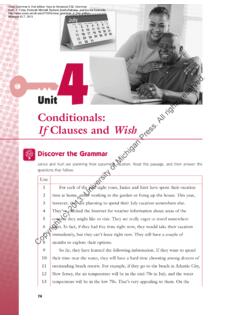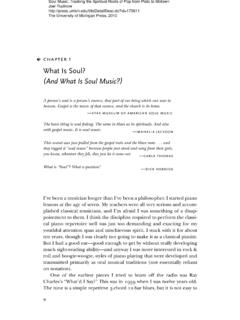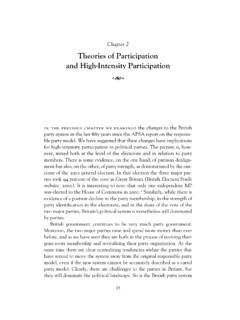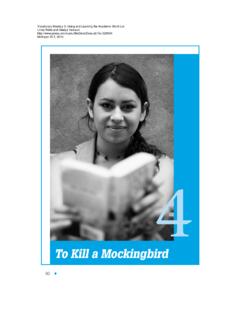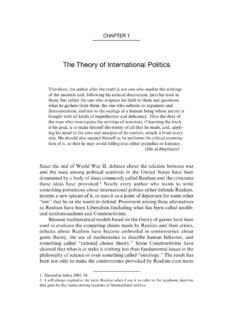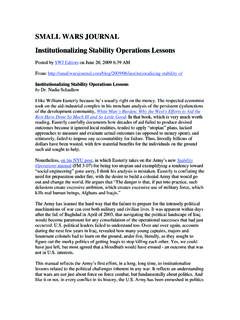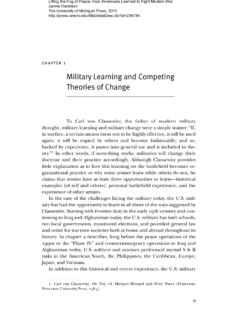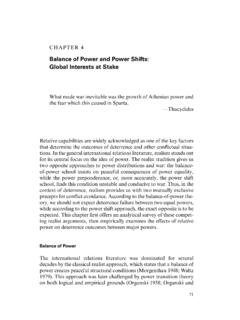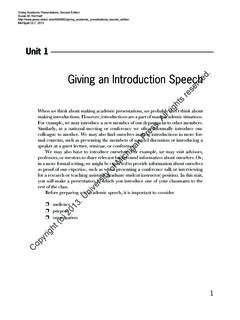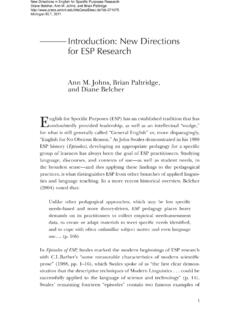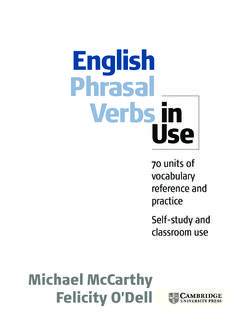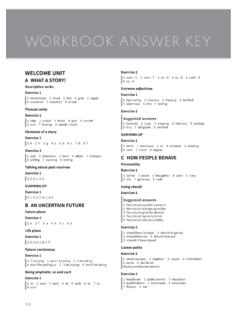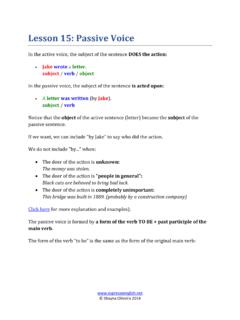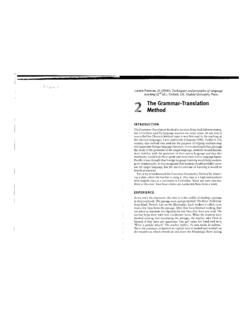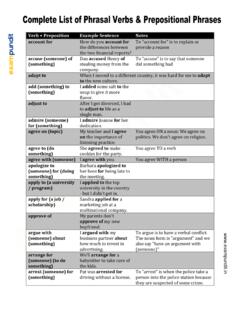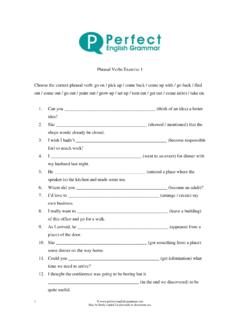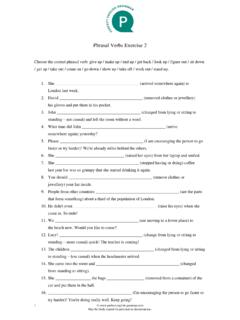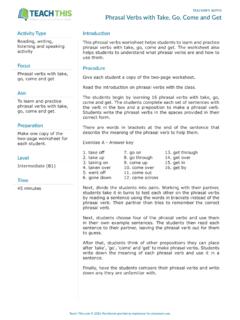Transcription of An IntroductIon to corpus LInguIstIcs
1 Using Corpora in the Language Learning Classroom: corpus LInguIstIcs for Teachers Gena R. Bennett Michigan ELT, 2010. Part 1. An IntroductIon to corpus LInguIstIcs Using Corpora in the Language Learning Classroom: corpus LInguIstIcs for Teachers Gena R. Bennett 2 Michigan Using ELT, 2010. Corpora in the Language Learning Classroom The principles of corpus LInguIstIcs have been around for almost a century. Lexicographers, or dictionary makers, have been collecting exam- ples of language in use to help accurately define words since at least the late 19th century. Before computers, these examples of language were essentially collected on small slips of paper and organized in pigeon holes.
2 The advent of computers led to the creation of what we consider to be modern-day corpora. The first computer- based corpus , the Brown corpus , was created in 1961 and comprised about 1 million words. Today, generalized corpora are hundreds of millions of words in size, and cor- pus LInguIstIcs is making outstanding contributions to the fields of second language research and teaching. What Is corpus LInguIstIcs ? So what exactly is corpus LInguIstIcs ? corpus LInguIstIcs approaches the study of language in use through corpora (singular: corpus ). A corpus is a large, principled collection of naturally occurring examples of language stored electronically.
3 In short, corpus LInguIstIcs serves to answer two fundamental research questions: 1. What particular patterns are associated with lexical or grammatical features? 2. How do these patterns differ within varieties and registers? Many notable scholars, have, of course, contributed to the development of mod- ern-day corpus LInguIstIcs : Leech, Biber, Johansson, Francis, Hunston, Conrad, and McCarthy, to name just a few. These scholars have made substantial contributions to corpus LInguIstIcs , both past and present. Many corpus linguists, however, consider John Sinclair to be one of, if not the most, influential scholar of modern-day corpus LInguIstIcs .
4 Sinclair detected that a word in and of itself does not carry meaning, but that meaning is often made through several words in a sequence (Sinclair, 1991). This is the idea that forms the backbone of corpus LInguIstIcs . What corpus LInguIstIcs Is Not It's important to not only understand what corpus LInguIstIcs is, but also what cor- pus LInguIstIcs is not. corpus LInguIstIcs is not able to provide negative evidence able to explain why able to provide all possible language at one time. Using Corpora in the Language Learning Classroom: corpus LInguIstIcs for Teachers Gena R.
5 Bennett Michigan ELT, 2010 An IntroductIon to corpus LInguIstIcs 3. corpus LInguIstIcs is not able to provide negative evidence. This means a corpus can't tell us what's possible or correct or not possible or incorrect in language; it can only tell us what is or is not present in the corpus . Many instructors mistakenly believe that if a corpus does not present all manners to express a certain idea, then the corpus is altogether faulty. Instead, instructors should believe that if a corpus does not present a particular manner to express a certain idea, then perhaps that manner is not very common in the register represented by the corpus .
6 corpus LInguIstIcs is not able to explain why something is the way it is, only tell us what is. To find out why, we, as users of language, use our intuition. corpus LInguIstIcs is not able to provide all possible language at one time. By definition, a corpus should be principled: a large, principled collection of naturally occurring texts.., meaning that the language that goes into a corpus isn't random, but planned. However, no matter how planned, principled, or large a corpus is, it can- not be a representative of all language. In other words, even in a corpus that contains one billon words, such as the Cambridge International corpus (CIC), all instances of use of a language may not be present.
7 Using Corpora in the Language Learning Classroom: corpus LInguIstIcs for Teachers Gena R. Bennett Michigan ELT, 2010. Chapter 1. Principles of corpus LInguIstIcs Questions We Can Answer with Corpora Broadly, corpus LInguIstIcs looks to see what patterns are associated with lexical and grammatical features. Searching corpora provides answers to questions like these: What are the most frequent words and phrases in English? What are the differences between spoken and written English? What tenses do people use most frequently? What prepositions follow particular verbs?
8 How do people use words like can, may, and might? Which words are used in more formal situations and which are used in more informal ones? How often do people use idiomatic expressions? How many words must a learner know to participate in everyday conversa- tion? How many different words do native speakers generally use in conversa- tion? (McCarthy, 2004, pp. 1 2). For the most part, these questions don't look particularly revolutionary. We already know the answers to a lot of them. We teach the ideas contained within many of these questions every day. We can open up almost any grammar, vocabulary, conversation, or writing textbook and find the answers.
9 Even better, we can apply our expert-user intuition to find the answers. We're intimately connected A frequency list displays to the language; after all, we speak it every day, right? An the words occurring in exercise may help here. For example, O'Keeffe, McCarthy, a corpus along with the and Carter (2007, p. 32) studied a frequency list from a 10. number of times each word appears. million word corpus and discovered that the 2,000 most fre- quent words in the corpus accounted for 80 percent of all the 4. Using Corpora in the Language Learning Classroom: corpus LInguIstIcs for Teachers Gena R.
10 Bennett Michigan ELT, 2010 1: Principles of corpus LInguIstIcs 5. words present. A mere 2 percent of the words were used repeatedly to account for 8. million words. For example, degree adverbs demonstrate the extent of a particular feature, such as thoroughly in the sentence, Her chocolate cake is thoroughly delicious. Keep this in mind, and think for a moment about these questions. XX What are some common adverbs of degree? Think of at least four. XX Give examples of ways you would use these adverbs. XX Which adverbs do you think are used more often in speaking?
